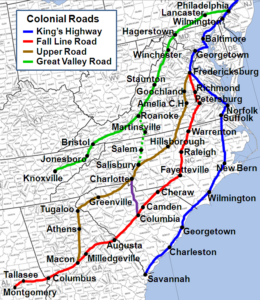The Kings Road was built from Philadelphia to Lancaster, PA in 1733. It became a section of the Great Wagon Road. It gradually stretched to Gettysburg, south to Hagerstown, Maryland, near Martinsburg, WV, south to Winchester, VA, then farther south to just north of Roanoke, Virginia where it merged with the Warrior Path (what you see on the map as Rt 220) but better known as the Valley (Turn) Pike. At Roanoke, formerly known as Big Lick, it was intersected by the Wilderness Road that crossed through the Cumberland Gap into Kentucky and Tennessee. Eventually, the Great Wagon Road stretched further southward through (Winston) Salem, North Carolina, on through Salisbury, NC, and onward to Camden, SC, and Augusta, GA.
Before 1744 the road marked a sort of boundary between American settlements to the East and what belonged to Native Americans to the West. When I say “West” I mean west of the Appalachian Mountain range. In the late 1770’s, a newer trail crossed the Wagon Road at Staunton, Va (pronounced “Stanton” by the locals, mind you) and the “road” was aptly named the Kanawha Trail for obvious reasons: It stretched westward to the Kanawha River. Kanawha, by the way, is pronounced Ka-NAW-uh. (I was born and raised there, so I know this to be a natural fact).
So, if you had visions of your ancestors walking across wide open plains from somewhere in Pennsylvania and Maryland to the verdant farmlands of Greenbrier County, guess again. These trails were cut initially by buffalo in search of SALT and couldn’t have been much wider than a buffalo (in those days). That should help you understand why so many places were named with the word “Lick” in them; it was a place where there was an outcropping of salt. Yes, Roanoke, Virginia was one of those places. Big Bone Lick State Park near Covington, KY is another example except, in those days, there were also bones of deceased mammoths. And of course, near Malden, WV, along the Kanawha River, is a saltworks where even today salt is mined for common use.
The Native Americans followed the buffalo trails on the hunt as did some of our earliest ancestors. So, when it came to “building” roads, the people followed the path of least resistance. It wasn’t a two-lane path, granted, and trees had to be felled to pull a wagon down it but as time marched on, the road became wider.
And it was BUSY with pioneers heading “west.” It was “west” of where they were living so don’t knock it.
So, pull out your maps and take a look at how this road and the other trails mentioned will open your eyes to the migratory path that our ancestors took as they pushed farther west into Kentucky and Tennessee.

